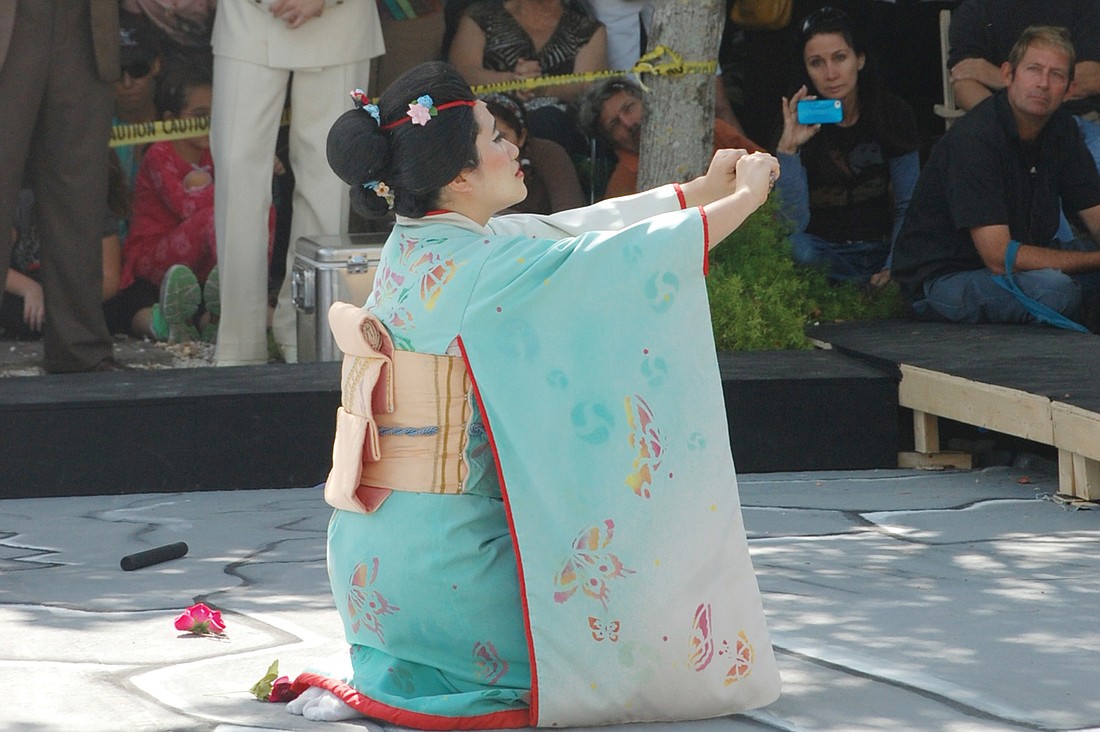- November 28, 2024
-
-
Loading

Loading

On Sunday, the Sarasota Opera moved Puccini’s “Madama Butterfly” outdoors to downtown’s Dolphin Street and Pineapple Avenue to meet the artists of The Chalk Festival. This may sound like a curious coupling, but it worked.
As a music person, my immediate question was: What does this collaboration do for the opera? On one hand, it brings hordes of people, many of them first-time opera attendees, so it’s good publicity and great public relations. But, on the other, they’re missing some of the opera’s important elements — the orchestra, a real stage, lighting, scenery, translating subtitles and the glorious sound of the operatic voice soaring into an enclosed space with acoustics meant for unamplified singing. And, because this outdoor “Butterfly” was condensed into less than an hour, they even missed out on some of the characters who flesh out the story.
Collaborations are always good because they get arts groups to think outside of their usual parameters. They also bring new audiences, and that’s important. Best of all, they’re fun, especially when they’re outside; the sky is blue, the air is balmy and the atmosphere is festive. Is it serious music or significant art? Sometimes. But it’s hard to draw the line on the folks who are standing around, hopping from one foot to another, weaving in and out, calling their kids, rounding up their dogs and wishing they’d chosen a bleacher seat (if they got one in the first place) in the shade.
All that being said, this is the kind of stuff we need to do more often in Sarasota.
Picture a rectangular space with bleachers on one end and a street on the other. The chalk artists have painted (or should I say drawn?) a colorful floor depicting the sea and sky in shades of blues, browns and khaki with white billowing clouds drifting across. The only scenery and props are properly spare: three black cubes, which double as tables and chairs, and, along one side, Japanese screens that hang like banners, placing an edge to the alleyway that’s been magically made into a stage.
It’s a smallish space as outdoor performances go and, unbelievably, microphones and other amplification weren’t used, which gave us a chance to hear the unadulterated voices. Of course, this also meant the “covers,” or understudies, we heard in the major roles could get carried away trying to make themselves heard and understood. Some succeeded more than others, mainly because the less-experienced singers felt the need to push and over sing instead of allowing us to hear them at their best, with the shadings and nuances necessary for this Puccini masterpiece.
Sharpless (baritone Matthew Hanscom) and Butterfly (Youna Jang) were the most successful and, possibly, the most experienced singers; they gave us some excellent acting and vocal performances, considering the circumstances. Jang was quite believable as the doomed rent-a-bride; she gave an amazingly thoughtful character to her Cio-Cio-San in the sunlight. The top of her voice flowers beautifully, but, although the middle and bottom are weaker (or was it the outdoor setting?) and need some heft, she did a lovely job with dynamics. She allowed her legato to carry her character to the audience without much trouble. Hanscom, a Merola Opera Program Young Artist, gave a highly polished reading of his role, and it would be interesting to hear him indoors.
Leah Kaye Serr sang an accommodating Suzuki, especially in the “Flower Duet,” but, due to timing constraints, her vocal participation was minor. Heath Huberg made a particularly young Pinkerton, looking in his Navy whites more like a high school drum major than the cad he’s meant to be. But he’s a good, strong tenor with a chance for a future if he’ll realize that he’s at his best when he doesn’t push. Or, as Jay Hunter Morris, the Met’s HD Siegfried, said just the day before during an intermission of that opera, he should learn “never to sing beyond what is beautiful.” Loud is not necessarily more.
Greg Trupiano, the opera’s artistic administrator, was the narrator, tying together the elements and story like a medieval troubadour, unaided by microphones but well able to lift his speaking voice and help us to skip over the bits we were missing and still make sense of the work.
Getting back to our original question, what does this kind of an outdoor performance do for the opera? As it turns out, quite a lot. There was a 7-year-old child sitting on the pavement in front of us. He barely breathed and moved only to wipe his brow during the hour-long presentation of “Butterfly.” He was genuinely entranced. If this kind of “street” performance makes even one new opera fan, it’s all worthwhile. To paraphrase the Sarasota Orchestra, this little boy came as he was and definitely left different.